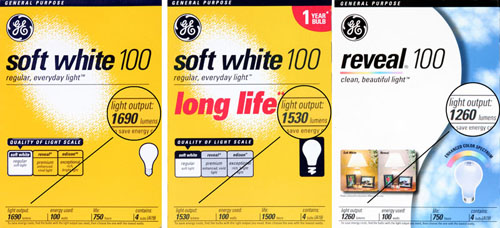I have been told, that incandescent light bulbs are being phased out to be replaced by fluorescent bulbs that use less energy. This will happen I think next year? Is that true? — CD, Abilene, Texas
Incandescent lightbulbs will be phased out beginning with 100-watt bulbs in 2012 and ending with 40-watt bulbs in 2014. The reason for this phase out is simple: incandescent lightbulbs are horribly energy inefficient.
Light is a form of energy, so you can compare the visible light energy emitted by any lamp to the energy that lamp consumes. According to that comparison, an incandescent lightbulb is roughly 5% efficient—a 100-watt incandescent bulb emits about 5 watts of visible light. In contrast, a fluorescent lamp is typically about 20% energy efficient—a 25-watt fluorescent lamp emits about 5 watts of visible light.
 |
 |
Another way to compare incandescent and fluorescent lamps is via their lumens per watt. The lumen is a standard unit of usable illumination and it incorporates factors such as how sensitive our eyes are to various colors of light. If you divide a light source’s light output in lumens by its power input in watts, you’ll obtain its lumens per watt.
For the incandescent lightbulb appearing at the left of the photograph, that calculation yields 16.9 lumens/watt. For the “long life” bulb at the center of the photograph, it give only 15.3 lumens/watt. And for the color-improved bulb on the right of the photograph, the value is only 12.6 lumens/watt. Our grandchildren will look at this photograph of long forgotten incandescent bulbs and be amazed that we could squander so much energy on lighting.
The fluorescent lamp in the other photograph is far more efficient. It produces more useful illumination than any of the three incandescent bulbs, yet it consumes just over a quarter as much power. Dividing its light out in lumens by its power consumption in watts yields 64.6 lumens/watts. It is 4 times as energy efficient as the best of the incandescent lightbulbs. Some fluorescent lamps are even more efficient than that.
Another feature to compare is life expectancy. Even the so-called “long life” incandescent predicts a 1500 hour life, which is only 15% of the predicted life for the fluorescent lamp (10,000 hours). Although the fluorescent costs more, it quickly pays for itself in energy use and less frequent replacement. You should recycle a fluorescent lamp because it does contain a tiny amount of mercury, but overall it’s a much more environmentally friendly light source.